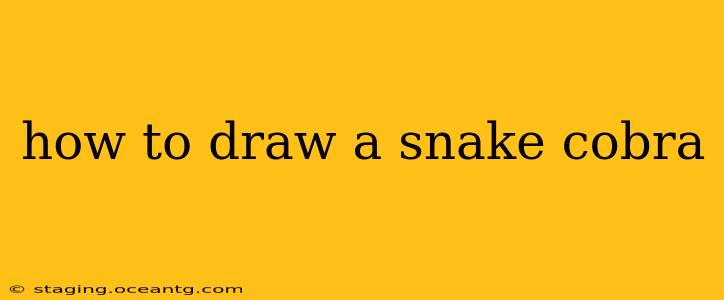Drawing a cobra, with its iconic hood and mesmerizing gaze, can be a rewarding experience. This guide will walk you through the process, from basic shapes to adding intricate details, catering to both beginners and those looking to refine their skills. Whether you're aiming for a realistic portrayal or a stylized interpretation, this guide offers valuable techniques.
Getting Started: Materials and Basic Shapes
Before we begin, gather your materials:
- Pencils: A range of hardness (e.g., HB, 2B, 4B) for sketching and shading.
- Eraser: A good quality eraser for correcting mistakes.
- Paper: Smooth drawing paper is ideal.
- Optional: Colored pencils, markers, or paints for adding color.
Let's start with the foundational shapes:
-
The Head: Begin by sketching a slightly elongated oval for the cobra's head. This oval should be wider at one end, forming the base for the hood.
-
The Hood: From the wider end of the oval, draw a slightly curved line extending outwards on either side. This creates the cobra's characteristic hood. Don't make it perfectly symmetrical; slight asymmetry adds realism.
-
The Body: From the narrower end of the head oval, sketch a long, slightly curving line to represent the body. The curve should be gentle, suggesting the snake's sinuous form. Consider how you want your cobra to be posed – coiled, striking, or slithering.
Refining the Cobra's Features
Now, let's add the defining features of a cobra:
-
Eyes: Draw small, round eyes within the head, positioning them slightly off-center. A small, dark pupil adds intensity to the gaze.
-
Fangs (Optional): If you want to depict a more menacing cobra, add small, pointed fangs just below the upper lip.
-
Scales: Cobras possess scales, which can be implied through subtle texturing. Use short, curved lines to suggest the overlapping scales on the head and body. Focus these lines in areas where the light would catch the scales, creating subtle highlights.
-
Tongue: A forked tongue adds to the cobra's reptilian nature. Draw two thin, pointed lines extending from the mouth.
-
Hood Markings: Many cobra species have distinctive markings on their hoods. Research your preferred species to accurately portray these markings. These can range from simple spots to intricate patterns. Experiment with different shading techniques to highlight these patterns.
Adding Detail and Shading
To enhance the realism of your drawing, focus on shading and detailing:
-
Shading: Use different pencil grades to create depth and dimension. Darker pencils (like 4B) will create shadows, while lighter pencils (like HB) will create highlights. Pay attention to where the light source is coming from and shade accordingly.
-
Texture: Further refine the scales by varying the pressure on your pencil, creating a sense of texture and depth.
-
Background (Optional): Adding a simple background can enhance the overall composition. Consider a desert landscape or a jungle setting.
Frequently Asked Questions (FAQs)
What is the best way to draw a cobra's hood?
The key to drawing a cobra's hood is to start with simple curved lines, creating a wider, almost fan-like shape from the head. Avoid making it perfectly symmetrical; subtle asymmetry will make it look more natural. Focus on the smooth transition from the head to the hood.
How do I make my cobra drawing look realistic?
Realism comes from attention to detail. Careful shading, textured scales, accurately depicted eyes, and a well-defined hood are crucial. Study reference images of cobras to understand their anatomy and markings.
What materials are best for drawing a cobra?
While pencils and paper are essential, you can explore different materials. Colored pencils, pastels, or even paints can add vibrancy and depth to your drawing. Experiment to find your preferred medium.
What are some tips for beginners drawing a cobra?
Begin with simple shapes and gradually add details. Don't be afraid to make mistakes; erasing and redrawing are part of the learning process. Use reference images, and start with a simple pose before tackling more complex ones. Practice regularly!
This detailed guide should provide you with the skills and knowledge to draw a magnificent cobra. Remember, practice is key. Don't be discouraged if your first attempt isn't perfect; keep practicing, and you'll see significant improvement over time.
